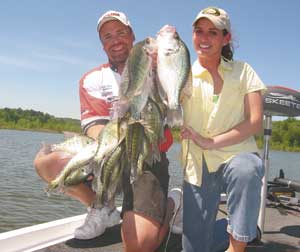
Catching monster sac-a-lait requires thinking outside the box.
I’d had a miserable day of crappie fishing, and only had caught three crappie all day.
Late in the afternoon while on the main section of the lake, I noticed a large tree lying in the water. Obviously the site had potential as a crappie hotspot. As I fished all the way around that fallen tree, I took three 8-inch-long crappie.
Looking to the center of that treetop, I saw a narrow opening about 4 inches wide between two branches. I had to tie my boat against the tree, lean out over a tree limb and swing my pole as far as I possibly could to try and hit the hole in the middle of the treetop. I knew if I caught a fish in that spot I’d have a very difficult time retrieving the crappie.
But just as my quill cork touched the surface of the water, it started descending and never stopped. I set the hook and fought a big slab to the surface. However, because of the extremely tight and narrow place I fished, I had to hold the crappie’s head out of the water until the fish turned sideways to allow me to pull it through the two limbs blocking the hole. The crappie weighed 1 3/4 pounds.
After quickly rebaiting, I performed the same gymnastic trick I had used to initially get my bait into that small hole in the center of the downed treetop. Once more my quill sank, and I threaded another large crappie out of the hole in the center of the treetop.
For two hours, I leaned over the limbs and fought slabs through the tree top. I finally completed my limit of 50 crappie, all weighing more than 1 1/2 pounds each, out of that same little spot in the submerged treetop.
I remembered the words of one of my crappie mentors, John Holley, who had told me, “If you’re going to catch big crappie, you can’t fish where everybody else fishes. You’ve got to be willing to get hung, break hooks, bust poles and fight bushes to take monster-sized crappie.
“Average anglers catch average-sized crappie. Big crappie are reserved for those willing to fight for them.”
Fight the weather
During the early years of professional crappie fishing, I always heard two names at the top of the leader board — Alan Padgett and Bobby Martin, both from Georgia. Even on the worst, windiest, rainiest, coldest days, these two anglers consistently would come to the scales with some of the biggest crappie taken in any tournament.
For years they kept their fishing strategies secret, but finally they told me how they regularly took big crappie, even on bad-weather days.
“I believe you catch some of the biggest crappie in any lake in deep water on main-river points,” Padgett said. “Bass fishermen know that you can catch plenty of bass on main river points too.
“On many lakes throughout the nation, one to 10 bass tournaments will be held on any given weekend. To try to develop a honeyhole to catch big bass, often tournament bass anglers will build brush shelters out on the ends of the main-river points.
“Most crappie fishermen, especially on bad, cold, windy, rough days, will retreat to the creeks and coves to fish visible cover out of the wind and weather. The least amount of crappie-fishing pressure in most lakes will be on main river points, where you must contend with boat traffic, heavy winds and often blowing rains.
“However, these are the spots we always try to fish to find the biggest crappie.”
Although some crappie fishermen have their doubts about the importance of color in catching crappie, Padgett and Martin believe that on certain days, big crappie will hit specific-colored jigs while little crappie prefer a different color of jigs.
“If we’re catching little crappie, we change the color of our jigs and often then will begin taking big crappie, Martin explained.
Click here to read the rest of this article, which first appeared in the January 2007 issue of Louisiana Sportsman.


